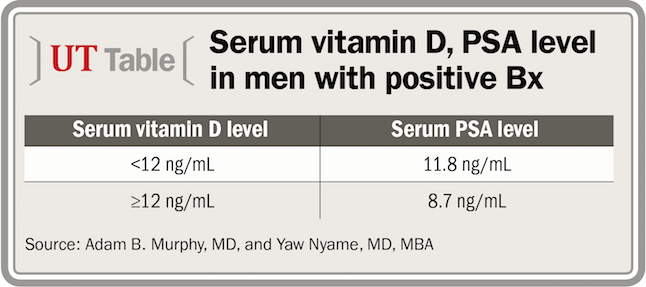Article
Vitamin D inversely correlated with PSA in PCa patients
Author(s):
Study findings suggest that high levels of vitamin D could be harmful to the prostate.
New Orleans-Serum vitamin D is inversely correlated with levels of PSA in men with prostate cancer, whereas serum vitamin D is inversely correlated with prostate volume in men without prostate cancer. Data from a cross-sectional study exploring these relationships were presented by Northwestern University researchers at the AUA annual meeting in New Orleans.
Recommended - USPSTF guide’s impact: The jury is still out
The cross-sectional study was nested from a large, case-control study in which mediators of vitamin D and prostate cancer were assessed among men 40 to 79 years of age who were prospectively enrolled in academic outpatient urology clinics in Chicago.
With laboratory evidence to suggest that vitamin D could slow the growth rate of prostate cells in both benign and cancerous cell models, “the thought was that vitamin D probably will correlate with prostate size and PSA level,” said principal investigator Adam B. Murphy, MD. Instead, a differential effect of vitamin D was found in benign and cancerous prostates.
NEXT: "Very complex" biology

“The biology is very complex,” said co-author Yaw Nyame, MD, MBA. “From a population standpoint, we are just now starting to get a glimpse as to what this hormone's effect on the prostate really is. Very clearly, it has a different effect on cancer biology than it does benign biology.”
Watch: Active surveillance for PCa has ‘hit the prime time’
All men in the study had transrectal ultrasound (TRUS)-guided biopsy for an elevated serum PSA or abnormal digital rectal examination, at which time peripheral blood was collected for serum vitamin D. Prostate volume was estimated by the ellipsoid formula during TRUS. The association of prostate volume, PSA, and PSA density with serum vitamin D was assessed using three vitamin D cut points (12, 16, and 20 ng/mL).

Dr. MurphyThese cut points were chosen to align with the Institute of Medicine’s definition of vitamin D deficiency based on the risk for osteoporosis.
“About 35% of the overall sample was vitamin D-deficient when defined as less than 20 ng/mL,” said Dr. Murphy, assistant professor in urology at Northwestern University Feinberg School of Medicine, Chicago. “The reason we used different cut points is that bone health doesn’t have much to do with what goes on in different tissues, so we can’t presume to know the right level.”
NEXT: Vitamin D inversely correlated with prostate volume
Vitamin D inversely correlated with prostate volume
The final sample contained 812 men. The median age of the 509 men with positive biopsies was 62.8 years and the median age for the 303 with negative biopsies was 61.5 years (p=.02). In the overall sample, serum vitamin D was inversely correlated with prostate volume for all the clinical cut points.
Also see: Green tea may suppress prostate cancer in high-risk men
When examined according to biopsy result, the predominant association in the men with positive biopsies was an inverse correlation between serum vitamin D and PSA levels. In this group, serum PSA was 11.8 ng/mL with serum vitamin D level <12 ng/mL, and 8.7 ng/mL in men with serum vitamin D ≥12 ng/mL (p=.005). The significant negative correlation between serum PSA and serum vitamin D remained when using 16 ng/mL serum vitamin D (p<.0001) and 20 ng/mL (p=.001) as cut points. A negative correlation between serum vitamin D and PSA density also showed significance at the 16 ng/mL (p=.03) and 20 ng/mL (p=.03) serum vitamin D cut points.
In the men with negative prostate biopsies, an inverse correlation was observed between serum vitamin D and prostate volume, with the correlation being significant when using 20 ng/mL as the cut point. Men with serum vitamin D level <20 ng/mL had a median prostate volume of 64.5 cm3, compared with 54.3 cm3 in men with serum vitamin D ≥20 ng/mL (p=.04).
NEXT: ‘A biomarker of aggressive disease’
‘A biomarker of aggressive disease’
These associations held when adjusting for known modifiers of serum PSA and prostate volume in multivariate regression models, said Dr. Nyame, a urology resident at Cleveland Clinic.
“We think that vitamin D is a biomarker of aggressive disease in cancer, so you would expect some correlation between both volume and PSA, but predominantly PSA for cancer patients,” Dr. Murphy told Urology Times. “It kind of helps us tease apart the relationship between PSA, volume, and vitamin D; and can you use vitamin D as a biomarker with the already established biomarkers?”
Dr. Nyame went one step further: “Vitamin D is not just a co-factor; it really has a purpose,” he said, noting that vitamin D is a hormone that exerts anti-angiogenic effects while also decreasing proliferation and increasing differentiation.
According to Dr. Murphy, the harm of excess vitamin D in cancer is concerning.
“You would expect it [serum vitamin D and PSA] to be positively correlated, but we don’t find that,” he said. “This means that vitamin D may in fact be bad for the prostate at high levels. That’s one important implication.”
More on Prostate Cancer
Upfront chemo called ‘standard’ in hormone-naïve PCa
Metformin/statin combo therapy reduces PCa mortality
Urine test accurately predicts high-grade prostate Ca
Subscribe to Urology Times to get monthly news from the leading news source for urologists.
Newsletter
Stay current with the latest urology news and practice-changing insights — sign up now for the essential updates every urologist needs.










Study shows persistent bone protective effect of menopausal hormone therapy
Metastasis-directed radiotherapy without systemic therapy yields promising outcomes in oligometastatic ccRCC
Aquablation procedures for prostate cancer completed at ambulatory surgery center
FDA grants priority review to expanded indication of flibanserin in HSDD
2 Commerce Drive
Cranbury, NJ 08512
All rights reserved.






